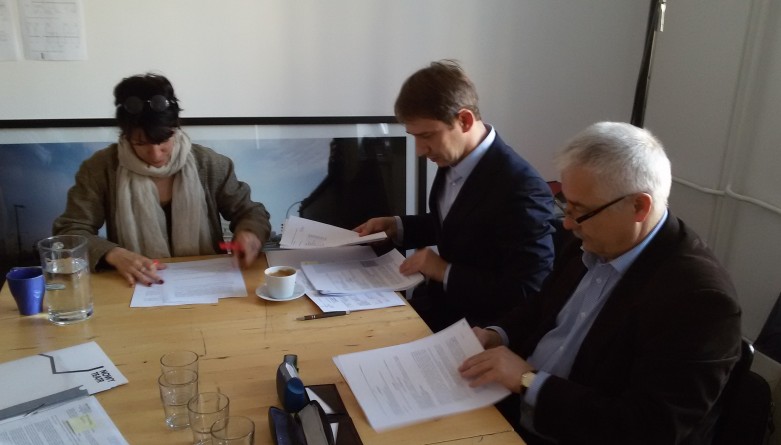Signing a contract with Skanska for construction works
On November 5 2014, Nowy Teatr signed a contract with Skanska SA for the construction of the Nowy Teatr International Cultural Centre, with Nowy Teatr as the Investor.
Adaptation of the old Municipal Waste Services depot
The project area covers 8,800 square meters. The contract covers the modernization and adaptation of the former Municipal Waste Services depot into a cultural and educational center. The adaptation will take place in the historic workshop hall and in parts of the administrative building. The works will also include the area surrounding the historic building used by the Nowy Teatr at 10/16 Madalińskiego Street.
Theatre hall, foyer and library
The adaptation of the workshop hall will give Nowy Teatr a multi-purpose theatre hall, a bookstore and a square for rest and recreation. The workshop hall, which dates from 1927, was entered in the register of historic buildings in 2008 and will form the key element of the Centre. Its greatest value lies in the reinforced concrete construction, with a 13 meter high central section meant to serve as a main theatre hall.
As part of the project, Skanska SA will modernize this historic workshop hall to serve as the new foyer and theatre hall, with rehearsal space, technical facilities and backstage. The company will also perform an acoustic adaptation of the selected rooms – says Jacek Królak, Site Manager for Skanska SA.
– In addition, we will build and fit out new toilets, utility rooms and bathrooms – he adds.
Skanska will also build a connection between the hall and the administrative building that will serve as the main entrance to the Centre all year round.
The foundations of the administrative building will be rebuilt, expanded and strengthened. There will be new stairs and toilets for the public in the basement, and also an outer ramp and veranda. The scope of the work will also include new interior and exterior woodwork, including reconstruction of the huge sliding doors of the workshop hall and the construction of new interior installations.
Skanska will partly remove and partly modernize the external part of the power grid, install new main connection sockets in the area, new natural and hard surfaces, necessary construction equipment, fences with gates and sliding panels, build several small architectural structures, as well as planting vegetation after the felling and pruning of some of the existing greenery – Jacek Królak lists.
– Towards the end we will deliver and mount the movable walls in the workshop hall – he adds.
Challenge – historic building
Working at a historic site will certainly pose a challenge – says the Site Manager. In order to restore the historic exterior plaster, reconstruct the gates of the workshop hall and re-use the old part of the electrical wiring, i.e. fittings, tubes, we will use the long-term experience of our specialists – he adds. The work will not be made easier by the short timeframe for the contract, but we can meet this challenge through a suitably designed work schedule.
New technology in a postwar building
The existing building was erected on the grounds of former clay pits, and therefore it slowly settled down. In order to strengthen the foundation of the post-war parts of the administrative building, we will use so-called micropiles. A foundation on micropiles is a type of deep foundation. These piles, reaching deep into the ground, carry the weight of the building to the more durable layers under the ground – says Jacek Królak.
– It is not a standard solution, but well known from similar Skanska constructions sites on similarly sensitive ground – says Królak.
Funds from Norway, Iceland and Liechtenstein
The works will start in November. The project will cost 17.8 million zlotys gross and is funded by Norwegian and EEA funds, coming from Iceland, Liechtenstein and Norway, as well as Polish national funds and the budget of the city of Warsaw.
Skanska and historic buildings
For many years, Skanska has revitalized historic buildings and areas under conservation protection. In close cooperation with conservator-restorers, Skanska beautifies the renovated buildings and public spaces. It thereby contributes to the improvement in their functionality and aesthetics. Skanska has successfully modernized Dwór Starościński (Starościński Manor) in Leżajsk and buildings belonging to the Castle Museum in Łańcut, i.e. Manege, Greenhouse – the Orchid House and Restaurant. In Kraków, Skanska renewed the Kościuszko Mound and the nearby "Kościuszko" Forts, while in Kielce the company revitalized the previous prison. In Wrocław, Skanska restored late 19th century buildings in Rydygiera street. In Poznań it renovated the 19th century "Pogamet" decorative metal element factory and the eastern wing of the Poznań Castle. In Piotrków Trybunalski Skanska reconstructed buildings of the 17th century Dominican Monastery and upgraded the energy and electricity plant EC-1 in Łódź, built in 1907. The experience of Skanska also includes renovation of the late 19th century Radogoszcz Villa and Skarbek Family Park in Grodzisk Mazowiecki and renovation of the castle hill in Sochaczew.
